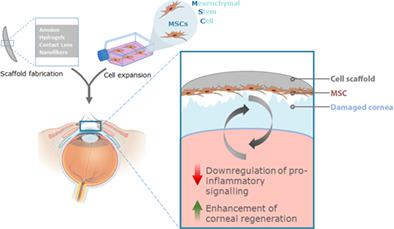当前位置:
X-MOL 学术
›
Stem Cells Transl. Med.
›
论文详情
Our official English website, www.x-mol.net, welcomes your feedback! (Note: you will need to create a separate account there.)
Potential of mesenchymal stem cells as topical immunomodulatory cell therapies for ocular surface inflammatory disorders.
STEM CELLS Translational Medicine ( IF 6 ) Pub Date : 2020-09-08 , DOI: 10.1002/sctm.20-0118 Lydia J Beeken 1 , Darren S J Ting 1 , Laura E Sidney 1
STEM CELLS Translational Medicine ( IF 6 ) Pub Date : 2020-09-08 , DOI: 10.1002/sctm.20-0118 Lydia J Beeken 1 , Darren S J Ting 1 , Laura E Sidney 1
Affiliation

|
Ocular surface inflammatory disorders (OSIDs) are a group of highly prevalent, heterogeneous diseases that display a variety of aetiologies and symptoms and are risk factors for serious complications, including ocular and cornea impairment. Corneal inflammation is a common factor of all OSIDs, regardless of their cause or symptoms. Current medications include over‐the‐counter lubricating eye drops, corticosteroids, and ciclosporin, which either do not treat the corneal inflammation or have been associated with multiple side effects leading to alternative treatments being sought. Regenerative medicine cell therapies, particularly mesenchymal stem cells (MSCs), have shown great promise for immunosuppression and disease amelioration across multiple tissues, including the cornea. However, for successful development and clinical translation of MSC therapy for OSIDs, significant problems must be addressed. This review aims to highlight considerations, including whether the source of MSC isolation impacts the efficacy and safety of the therapy, in addition to assessing the feasibility of MSC topical application to the cornea and ocular surface through analysis of potential scaffolds and cell carriers for application to the eye. The literature contains limited data assessing MSCs incorporated into scaffolds for corneal administration, thus here we highlight the necessity of further investigations to truly exploit the potential of an MSC‐based cell therapy for the treatment of OSIDs.
中文翻译:

间充质干细胞作为眼表炎症性疾病的局部免疫调节细胞疗法的潜力。
眼表炎症性疾病 (OSID) 是一组高度流行的异质性疾病,具有多种病因和症状,是包括眼部和角膜损伤在内的严重并发症的危险因素。角膜炎症是所有 OSID 的共同因素,无论其原因或症状如何。目前的药物包括非处方润滑眼药水、皮质类固醇和环孢素,它们要么不能治疗角膜炎症,要么与多种副作用有关,导致正在寻求替代治疗。再生医学细胞疗法,特别是间充质干细胞 (MSCs),在包括角膜在内的多个组织中显示出免疫抑制和疾病改善的巨大希望。然而,对于 OSID 的 MSC 疗法的成功开发和临床转化,必须解决重大问题。本综述旨在强调考虑因素,包括 MSC 分离的来源是否会影响治疗的功效和安全性,此外还通过分析潜在的支架和细胞载体来评估 MSC 局部应用于角膜和眼表的可行性,以应用于眼。文献中包含的评估 MSCs 纳入角膜给药支架的数据有限,因此我们在此强调了进一步研究的必要性,以真正利用基于 MSC 的细胞疗法治疗 OSIDs 的潜力。包括 MSC 分离的来源是否影响治疗的功效和安全性,此外还通过分析用于眼部的潜在支架和细胞载体来评估 MSC 局部应用于角膜和眼表的可行性。文献中包含的评估 MSCs 纳入角膜给药支架的数据有限,因此我们在此强调了进一步研究的必要性,以真正利用基于 MSC 的细胞疗法治疗 OSIDs 的潜力。包括 MSC 分离的来源是否影响治疗的功效和安全性,此外还通过分析用于眼部的潜在支架和细胞载体来评估 MSC 局部应用于角膜和眼表的可行性。文献中包含的评估 MSCs 纳入角膜给药支架的数据有限,因此我们在此强调了进一步研究的必要性,以真正利用基于 MSC 的细胞疗法治疗 OSIDs 的潜力。
更新日期:2020-09-08
中文翻译:

间充质干细胞作为眼表炎症性疾病的局部免疫调节细胞疗法的潜力。
眼表炎症性疾病 (OSID) 是一组高度流行的异质性疾病,具有多种病因和症状,是包括眼部和角膜损伤在内的严重并发症的危险因素。角膜炎症是所有 OSID 的共同因素,无论其原因或症状如何。目前的药物包括非处方润滑眼药水、皮质类固醇和环孢素,它们要么不能治疗角膜炎症,要么与多种副作用有关,导致正在寻求替代治疗。再生医学细胞疗法,特别是间充质干细胞 (MSCs),在包括角膜在内的多个组织中显示出免疫抑制和疾病改善的巨大希望。然而,对于 OSID 的 MSC 疗法的成功开发和临床转化,必须解决重大问题。本综述旨在强调考虑因素,包括 MSC 分离的来源是否会影响治疗的功效和安全性,此外还通过分析潜在的支架和细胞载体来评估 MSC 局部应用于角膜和眼表的可行性,以应用于眼。文献中包含的评估 MSCs 纳入角膜给药支架的数据有限,因此我们在此强调了进一步研究的必要性,以真正利用基于 MSC 的细胞疗法治疗 OSIDs 的潜力。包括 MSC 分离的来源是否影响治疗的功效和安全性,此外还通过分析用于眼部的潜在支架和细胞载体来评估 MSC 局部应用于角膜和眼表的可行性。文献中包含的评估 MSCs 纳入角膜给药支架的数据有限,因此我们在此强调了进一步研究的必要性,以真正利用基于 MSC 的细胞疗法治疗 OSIDs 的潜力。包括 MSC 分离的来源是否影响治疗的功效和安全性,此外还通过分析用于眼部的潜在支架和细胞载体来评估 MSC 局部应用于角膜和眼表的可行性。文献中包含的评估 MSCs 纳入角膜给药支架的数据有限,因此我们在此强调了进一步研究的必要性,以真正利用基于 MSC 的细胞疗法治疗 OSIDs 的潜力。

























 京公网安备 11010802027423号
京公网安备 11010802027423号